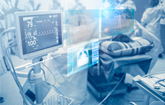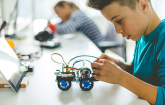BANGALORE, India, May 22, 2025 /PRNewswire/ -- Neurostimulation Devices Market is Segmented by Type (Spinal Cord Stimulation (SCS), Gastric Electric Stimulation (GES), Deep Brain Stimulation (DBS), Sacral Nerve Stimulation (SNS), Vagus Nerve Stimulation (VNS)), by Application (Pain Management, Parkinson's Disease, Urinary and Fecal Incontinence, Epilepsy, Gastroparesis).
The Global Neurostimulation Devices revenue was USD 8212 Million in 2024 and is forecast to a readjusted size of USD 17200 Million by 2031 with a CAGR of 11.3% during the forecast period (2024-2031).
Claim Your Free Report: https://reports.valuates.com/request/sample/QYRE-Auto-27V15737/Global_and_India_Neurostimulation_Devices_Market
Major Factors Driving the Growth of Neurostimulation Devices Market:
The neurostimulation devices market is witnessing robust growth due to rising cases of neurological disorders, chronic pain, and treatment-resistant conditions. Factors such as growing aging populations, patient preference for non-invasive treatments, and expanding therapeutic applications are reinforcing demand. The market is highly competitive, with innovation driving differentiation among players. Increasing collaborations and supportive reimbursement policies are enhancing accessibility and affordability. With expanding indications and geographic reach, the market is poised for sustained expansion in the coming years. Tailored device development and integration of digital tools further ensure that neurostimulation remains a cornerstone of future neurological and chronic care.
Unlock Insights: View Full Report Now! https://reports.valuates.com/market-reports/QYRE-Auto-27V15737/global-and-india-neurostimulation-devices
TRENDS INFLUENCING THE GROWTH OF THE NEUROSTIMULATION DEVICES MARKET:
Deep Brain Stimulation (DBS) has emerged as a crucial therapeutic option for neurological disorders such as Parkinson's disease, essential tremor, and dystonia. The growing prevalence of these chronic conditions, coupled with patient preference for non-pharmacological interventions, has significantly increased demand for DBS systems. Advancements in electrode precision, battery longevity, and minimally invasive surgical techniques have further boosted its adoption. Hospitals and specialized neurological centers are increasingly integrating DBS into treatment protocols, driven by its effectiveness in improving motor function and reducing medication dependence. Additionally, growing clinical research and favorable reimbursement structures in developed nations are promoting early diagnosis and treatment, thus enhancing the uptake of DBS devices. This steady demand trajectory is significantly fueling market growth.
Spinal Cord Stimulation (SCS) has gained traction as a leading solution for chronic pain management, especially for conditions like failed back surgery syndrome and complex regional pain syndrome. The rise in opioid-related concerns has led healthcare professionals and patients to opt for alternative pain therapies, with SCS emerging as a safe and effective method. Technological innovations, such as high-frequency stimulation and closed-loop systems, are enhancing therapeutic outcomes, leading to broader acceptance among clinicians. Moreover, increasing awareness among patients and growing investments in outpatient and ambulatory care settings are expanding the market for SCS. The consistent adoption of these devices across both developed and emerging economies is reinforcing the growth of the neurostimulation devices market.
The global burden of Parkinson's Disease (PD) is rising steadily due to aging populations and increased disease awareness. As a progressive neurological disorder with no cure, PD demands long-term symptom management strategies, which has spotlighted neurostimulation therapies such as DBS. Patients with advanced Parkinson's often face motor fluctuations and medication side effects, making neurostimulation a valuable tool in enhancing quality of life. Governments and healthcare institutions are funding initiatives to improve access to PD treatments, supporting the installation of DBS systems in hospitals. Furthermore, clinical trials and new DBS approvals tailored specifically to PD symptoms are expanding product portfolios, which collectively contribute to the sustained growth of the neurostimulation devices market.
The increasing global incidence of neurological conditions such as Parkinson's disease, epilepsy, and chronic pain disorders is significantly driving the neurostimulation devices market. These conditions often require long-term management, and neurostimulation provides an effective non-pharmacological approach, reducing dependency on medications and associated side effects. As populations age, the burden of such disorders is expected to rise, particularly in countries with expanding geriatric demographics. This creates consistent demand for both invasive and non-invasive neurostimulation therapies. The broadening clinical acceptance and inclusion of these therapies in treatment guidelines across healthcare systems further underscore their relevance, contributing to ongoing market growth.
Minimally invasive techniques have revolutionized the neurostimulation landscape by offering lower risk, quicker recovery, and improved outcomes. As medical technology advances, devices used in neurostimulation are becoming more efficient and patient-friendly. These developments reduce hospitalization times and make procedures more accessible in outpatient settings. Patients are also more willing to adopt minimally invasive solutions, which boosts procedural volume. Additionally, healthcare providers benefit from reduced operational costs, creating a win-win situation that fosters sustained demand. This paradigm shift toward less invasive treatment methods is a key factor accelerating the growth of the neurostimulation devices market.
Governments and private insurers are increasingly recognizing the cost-effectiveness and clinical benefits of neurostimulation therapies. In response, reimbursement coverage has expanded in many countries for devices such as DBS and SCS. Regulatory agencies like the FDA and EMA are also streamlining approval pathways to encourage faster access to new and improved neurostimulation devices. These policies enhance patient affordability and physician willingness to recommend such treatments. Moreover, favorable reimbursement policies support hospital procurement of high-cost devices, ensuring wider adoption. The alignment of regulatory support and economic incentives is thus contributing significantly to the market's rapid expansion across multiple regions.
Developing economies are investing significantly in healthcare infrastructure, making advanced neurological care more accessible. Countries in Asia-Pacific, Latin America, and the Middle East are witnessing an influx of neurological clinics, specialized treatment centers, and skilled neurosurgeons. These developments are accompanied by growing government interest in adopting cutting-edge medical technologies. Additionally, international collaborations and training programs are enhancing healthcare professionals' capability to use neurostimulation devices. As awareness increases and affordability improves through local manufacturing and tiered pricing strategies, these markets are expected to contribute substantially to the overall growth of the neurostimulation devices industry.
Claim Yours Now! https://reports.valuates.com/api/directpaytoken?rcode=QYRE-Auto-27V15737&lic=single-user
NEUROSTIMULATION DEVICES MARKET SHARE
North America dominates the neurostimulation devices market, driven by robust healthcare infrastructure, favorable reimbursement systems, and early adoption of innovative treatments.
Europe follows closely due to increasing neurological disorder prevalence and proactive regulatory support.
The Asia-Pacific region is emerging rapidly, supported by rising healthcare investments, growing awareness, and improved accessibility to advanced therapies in countries like China, India, and Japan.
Key Companies:
- Medtronic Inc
- Boston Scientific
- Abbott
- LivaNova
- Nevro
- NeuroPace Inc
- Beijing Pins
- Synapse Biomedical
Purchase Chapters: https://reports.valuates.com/request/chaptercost/QYRE-Auto-27V15737/Global_and_India_Neurostimulation_Devices_Market
SUBSCRIPTION
We have introduced a tailor-made subscription for our customers. Please leave a note in the Comment Section to know about our subscription plans.
DISCOVER MORE INSIGHTS: EXPLORE SIMILAR REPORTS!
- The global market for Implantable Neurostimulation Devices was valued at USD 5986 Million in the year 2024 and is projected to reach a revised size of USD 11700 Million by 2031, growing at a CAGR of 10.2% during the forecast period.
- The global market for Neurology Diagnostics Devices was valued at USD 13460 Million in the year 2024 and is projected to reach a revised size of USD 20000 Million by 2031, growing at a CAGR of 5.9% during the forecast period.
- The global market for Low-Frequency Sine Wave Neurostimulation Therapy Devices was estimated to be worth USD 5142 Million in 2023 and is forecast to a readjusted size of USD 8811.9 Million by 2030 with a CAGR of 8.0% during the forecast period 2024-2030.
- The global Neuromodulation and Neurostimulation Pain Management Devices market was valued at USD 2116 Million in 2023 and is anticipated to reach USD 3293 Million by 2030, witnessing a CAGR of 6.4% during the forecast period 2024-2030.
- The global Nerve Repair and Regeneration Devices market was valued at USD 6650 Million in 2023 and is anticipated to reach USD 10430 Million by 2030, witnessing a CAGR of 6.6% during the forecast period 2024-2030.
- Neuro Medical Devices Market
- Non-Invasive Neuromodulatory Devices Market
- The global market for Neurology Equipment was valued at USD 825 Million in the year 2024 and is projected to reach a revised size of USD 1140 Million by 2031, growing at a CAGR of 4.8% during the forecast period.
- The global market for Neurotechnology Device was estimated to be worth USD 10980 Million in 2023 and is forecast to a readjusted size of USD 18330 Million by 2030 with a CAGR of 7.6% during the forecast period 2024-2030.
- The global market for Intracranial Neurosurgery was valued at USD 5480 Million in the year 2024 and is projected to reach a revised size of USD 7624 Million by 2031, growing at a CAGR of 4.9% during the forecast period.
- Spinal Cord Neurostimulation Implant Market
DISCOVER OUR VISION: VISIT ABOUT US!
Valuates offers in-depth market insights into various industries. Our extensive report repository is constantly updated to meet your changing industry analysis needs.
Our team of market analysts can help you select the best report covering your industry. We understand your niche region-specific requirements and that's why we offer customization of reports. With our customization in place, you can request for any particular information from a report that meets your market analysis needs.
To achieve a consistent view of the market, data is gathered from various primary and secondary sources, at each step, data triangulation methodologies are applied to reduce deviance and find a consistent view of the market. Each sample we share contains a detailed research methodology employed to generate the report. Please also reach our sales team to get the complete list of our data sources.
GET A FREE QUOTE
Valuates Reports
sales@valuates.com
For U.S. Toll-Free Call 1-(315)-215-3225
WhatsApp: +91-9945648335
Website: https://reports.valuates.com
Blog: https://valuatestrends.blogspot.com/
Pinterest: https://in.pinterest.com/valuatesreports/
Twitter: https://twitter.com/valuatesreports
Facebook: https://www.facebook.com/valuatesreports/
YouTube: https://www.youtube.com/@valuatesreports6753
https://www.facebook.com/valuateskorean
https://www.facebook.com/valuatesspanish
https://www.facebook.com/valuatesjapanese
https://valuatesreportspanish.blogspot.com/
https://valuateskorean.blogspot.com/
https://valuatesgerman.blogspot.com/
https://valuatesreportjapanese.blogspot.com/
Logo - https://mma.prnewswire.com/media/1082232/5334041/Valuates_Reports_Logo.jpg







Share this article